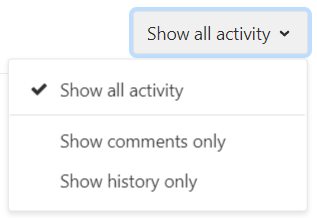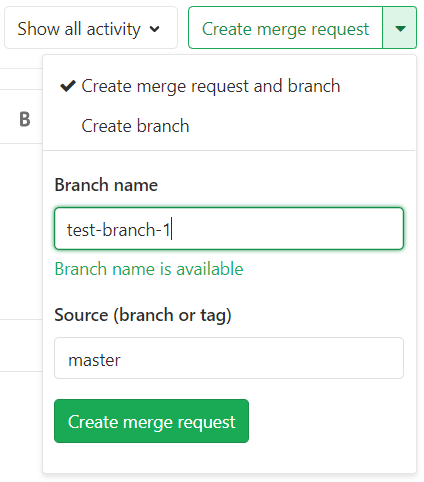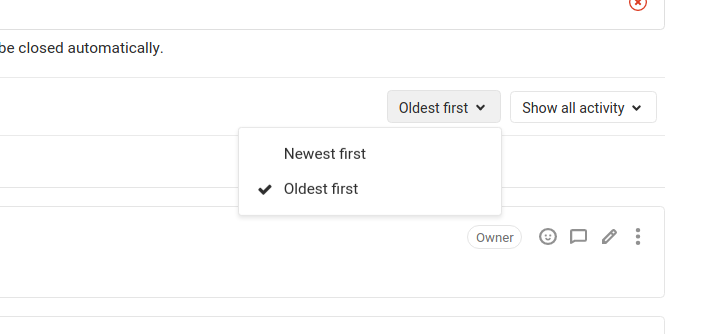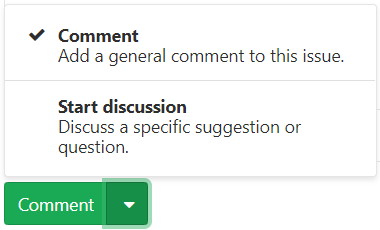Issue Data and Actions
Please read through the GitLab Issue Documentation for an overview on GitLab Issues.
Parts of an Issue
The image below illustrates what an issue may look like. Certain parts look slightly different or are absent, depending on the GitLab version and the user's permissions.
You can find all of an issue's information on one page.
The numbers in the image correspond to the following features:
- 1. Issue actions
- 2. To Do
- 3. Assignee
- 4. Epic (PREMIUM)
- 5. Milestone
- 6. Time tracking
- 7. Due date
- 8. Labels
- 9. Weight (STARTER)
- 10. Confidentiality
- 11. Lock issue
- 12. Participants
- 13. Notifications
- 14. Reference
- Issue email
- 15. Edit
- 16. Description
- 17. Mentions
- 18. Related Issues
- 19. Related Merge Requests
- 20. Award emoji
- 21. Show all activity
- 22. Create Merge Request
- 23. Issue history
- 24. Comments
- 25. Submit comment, start a thread, or comment and close
- 26. Zoom meetings
Many of the elements of the issue screen refresh automatically, such as the title and description, when they are changed by another user. Comments and system notes also update automatically in response to various actions and content updates.
Issue actions
In an open issue, you can close it by selecting the Close issue button. The issue is marked as closed but is not deleted.
To reopen a closed issue, select the Reopen issue button. A reopened issue is no different from any other open issue.
To access additional actions, select the vertical ellipsis ({ellipsis_v}) button:
-
To create a new issue in the same project, select New issue in the dropdown menu.
-
If you are not the issue author, you can submit an abuse report. Select Report abuse in the dropdown menu.
To Do
You can add issues to and remove issues from your GitLab To-Do List.
The button to do this has a different label depending on whether the issue is already on your To-Do List or not. If the issue is:
- Already on your To-Do List: The button is labeled Mark as done. Click the button to remove the issue from your To-Do List.
- Not on your To-Do List: The button is labeled Add a to do. Click the button to add the issue to your To-Do List.
Assignee
An issue can be assigned to:
- Yourself.
- Another person.
- Many people. (STARTER)
The assignees can be changed as often as needed. The idea is that the assignees are responsible for that issue until it's reassigned to someone else to take it from there. When assigned to someone, it appears in their assigned issues list.
NOTE: If a user is not member of that project, it can only be assigned to them if they created the issue themselves.
Multiple Assignees (STARTER)
Often, multiple people work on the same issue together. This can be difficult to track in large teams where there is shared ownership of an issue.
In GitLab Starter, you can assign multiple people to an issue.
Epic (PREMIUM)
You can assign issues to an Epic, which allows better management of groups of related issues.
Milestone
Select a milestone to attribute that issue to.
Time tracking
Use GitLab Quick Actions to track estimates and time spent on issues. You can add a time estimate for resolving the issue, and also add the time spent to resolve the issue.
Due date
When you work on a tight schedule, it's important to have a way to set a deadline for implementations and for solving problems. This can be done in the due date element. Due dates can be changed as many times as needed.
Labels
Categorize issues by giving them labels. They help to organize workflows, and they enable you to work with the GitLab Issue Board.
Group Labels, which allow you to use the same labels for all projects in the same group, can also be given to issues. They work exactly the same, but are immediately available to all projects in the group.
If a label doesn't exist yet, you can create one by clicking Edit followed by Create new label in the dropdown menu.
Weight (STARTER)
Assign a weight to an issue. Larger values are used to indicate more effort is required to complete the issue. Only positive values or zero are allowed.
Confidentiality
You can set an issue to be confidential. Unauthorized users cannot access the issue, and it is not listed in the project's issue boards nor list for them.
Lock issue
You can lock the threads in the issue, to prevent further comments from being added.
Participants
All the users involved in that issue. Either they participated in the thread, or were mentioned in the description or threads.
Notifications
Click on the icon to enable/disable notifications for the issue. Notifications are automatically enabled after you participate in the issue in any way.
- Enable: If you are not a participant in the discussion on that issue, but want to receive notifications on each update, subscribe to it.
- Disable: If you are receiving notifications for updates to that issue but no longer want to receive them, unsubscribe from it.
Reference
- A quick "copy" button for that issue's reference, which looks like
foo/bar#xxx, wherefoois theusernameorgroupname,baris theproject-name, andxxxis the issue number.
Introduced in GitLab 13.8.
Guest users can see a button in the right sidebar to copy the email address for the issue. Sending an email to this address creates a comment containing the email body.
Edit
Clicking this icon opens the issue for editing. All the fields which were shown when the issue was created are displayed for editing. This icon is only displayed if the user has permission to edit the issue.
Description
The plain text title and description of the issue fill the top center of the issue page. The description fully supports GitLab Flavored Markdown, allowing many formatting options.
In GitLab 12.6 and later, changes to an issue's description are listed in the issue history. (STARTER)
Mentions
You can mention a user or a group present in your GitLab instance with @username or
@groupname. All mentioned users are notified via to-do items and emails,
unless they have disabled all notifications in their profile settings.
This is controlled in the notification settings.
Mentions for yourself (the current logged in user) are highlighted in a different color, which allows you to quickly see which comments involve you.
Avoid mentioning @all in issues and merge requests, as it sends an email notification
to all the members of that project's group. This might be interpreted as spam.
Related Issues
Issues that were mentioned as related issues are listed here.
You can also click the + to add more related issues.
Related Merge Requests
Merge requests that were mentioned in that issue's description or in the issue thread are listed as related merge requests here. Also, if the current issue was mentioned as related in another merge request, that merge request is also listed here.
Award emoji
You can award emojis to issues. You can select the "thumbs up" and "thumbs down", or the gray "smiley-face" to choose from the list of available GitLab Flavored Markdown Emoji.
NOTE: Posting "+1" as a comment in a thread spams all subscribed participants of that issue, clutters the threads, and is not recommended. Awarding an emoji is a way to let them know your reaction without notifying them.
Show all activity
You can filter what is displayed in the issue history by clicking on Show all activity and selecting either:
- Show comments only, which only shows threads and hides updates to the issue.
- Show history only, which hides threads and only shows updates.
Also:
- You can mention a user or a group present in your GitLab instance with
@usernameor@groupnameand they are notified via to-do items and emails, unless they have disabled all notifications in their profile settings. - Mentions for yourself (the current logged-in user) are highlighted in a different color, which allows you to quickly see which comments involve you.
Create Merge Request
Create a new branch and Draft merge request
in one action. The branch is named issuenumber-title by default, but you can
choose any name, and GitLab verifies that it is not already in use. The merge request
inherits the milestone and labels of the issue, and is set to automatically
close the issue when it is merged.
Optionally, you can choose to create a new branch only, named after that issue.
Issue history
All comments and updates to the issue are tracked and listed here, but this can be filtered, as shown above.
Activity sort order
Introduced in GitLab 12.10.
You can reverse the default order and interact with the activity feed sorted by most recent items at the top. Your preference is saved via local storage and automatically applied to every issue you view.
To change the activity sort order, click the Oldest first dropdown menu and select either oldest or newest items to be shown first.
Comments
Collaborate in the issue by posting comments in its thread. This text field also fully supports GitLab Flavored Markdown.
Submit comment, start a thread, or comment and close
After you write a comment, you can:
- Click Comment and to publish your comment.
- Choose Start thread from the dropdown list and start a new thread in that issue's main thread to discuss specific points. This invites other participants to reply directly to your thread, keeping related comments grouped together.
You can also close the issue from here, so you don't need to scroll to the top of the issue page.
Zoom meetings
Introduced in GitLab 12.3.
You can attach and remove Zoom meetings to issues using the /zoom and /remove_zoom quick actions as part of
GitLab Flavored Markdown.
Attaching a Zoom call an issue results in a Join Zoom meeting button at the top of the issue, just under the header.
Read more how to add or remove a zoom meeting.
Publish an issue (ULTIMATE)
Introduced in GitLab Ultimate 13.1.
If a status page application is associated with the project, you can use the /publish quick action to publish the issue. Refer to GitLab Status Page for more information.




